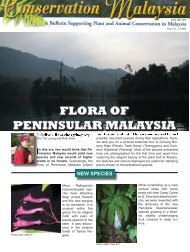A Bulletin Supporting Plant and Animal Conservation in Malaysia
A Bulletin Supporting Plant and Animal Conservation in Malaysia
A Bulletin Supporting Plant and Animal Conservation in Malaysia
Create successful ePaper yourself
Turn your PDF publications into a flip-book with our unique Google optimized e-Paper software.
2<br />
3<br />
4<br />
5<br />
At present <strong>in</strong> <strong>Malaysia</strong> there are large gaps of <strong>in</strong>formation<br />
not only about ectomycorrhizal agarics <strong>and</strong> boletes<br />
but also for saprobic <strong>and</strong> parasitic macromycetes. The<br />
present economic wealth of <strong>Malaysia</strong> <strong>and</strong> its population<br />
are directly dependent on primary products generated<br />
<strong>in</strong> plantations, e.g. of rubber trees <strong>and</strong> oil palms. It is<br />
uncerta<strong>in</strong> how the mycelia of the ecologically adjusted,<br />
native (<strong>and</strong> also accidentally <strong>in</strong>troduced) saprobic <strong>and</strong><br />
parasitic fungi will <strong>in</strong>teract with <strong>in</strong>troduced alien host<br />
plants under long-term stress caused by monoculture<br />
<strong>and</strong>/or climate change. In order to be prepared for any<br />
negative impacts, it is imperative to accelerate research<br />
<strong>in</strong> taxonomy <strong>and</strong> ecology of the largely unknown<br />
parasitic <strong>and</strong> aggressive saprobic macrofungi <strong>in</strong>volved<br />
(e.g. Armillariella, Cr<strong>in</strong>ipellis, Gymnopilus, Marasmius,<br />
Pholiota, etc.). Under these circumstances it is obvious<br />
that more relevant mycological research data are<br />
needed with regard to conservation <strong>and</strong> susta<strong>in</strong>able<br />
management both <strong>in</strong> native tropical forests <strong>and</strong> <strong>in</strong> manmade<br />
plantations.<br />
In March – April 2009, jo<strong>in</strong>t mycological field work<br />
was carried out with the team of Dr. S.S. Lee of FRIM,<br />
both <strong>in</strong> the lowl<strong>and</strong> dipterocarp forests <strong>in</strong> the Endau-<br />
Romp<strong>in</strong> State Park (Fig. 1) <strong>and</strong> <strong>in</strong> montane fagaceous<br />
forests of Cameron Highl<strong>and</strong>s. Numerous specimens of<br />
agarics (Fig. 2) <strong>and</strong> boletes (Fig. 3) endemic <strong>in</strong> South<br />
East Asian habitats were collected, carefully annotated,<br />
photographed <strong>in</strong> fresh condition, dried, <strong>and</strong> are now<br />
await<strong>in</strong>g identification <strong>and</strong> publication. The first<br />
evaluation of the collections demonstrated that at least<br />
one genus (Fig. 4) <strong>and</strong> several species of agarics <strong>and</strong>/<br />
or boletes are new to science or were discovered for<br />
the first time on <strong>Malaysia</strong>n soil. In addition new data<br />
<strong>and</strong> complementary <strong>in</strong>formation about rare or poorly<br />
known macromycetes with respect to ecology <strong>and</strong><br />
distribution (Fig. 5) were documented.<br />
2. Entoloma altissimum (Massee) E.Horak (orig<strong>in</strong>ally<br />
reported from S<strong>in</strong>gapore, first record for <strong>Malaysia</strong>).<br />
3. Heimioporus japonicus (Hongo) E.Horak (first<br />
record for <strong>Malaysia</strong>).<br />
4. New genus, aff. “Xerula” (Cameron Highl<strong>and</strong>s).<br />
5. Pulveroboletus viridisquamosus Watl<strong>in</strong>g, Turnbull<br />
& S.S.Lee (endemic to <strong>Malaysia</strong>).<br />
Reference:<br />
Hawksworth, D.L. (1993). The tropical fungal biota:<br />
census, pert<strong>in</strong>ence, prophylaxis, <strong>and</strong> prognosis. In:<br />
Isaac, S. et al. (eds.): Aspects of Tropical Mycology.<br />
British Mycological Society. University Press,<br />
Cambridge.



